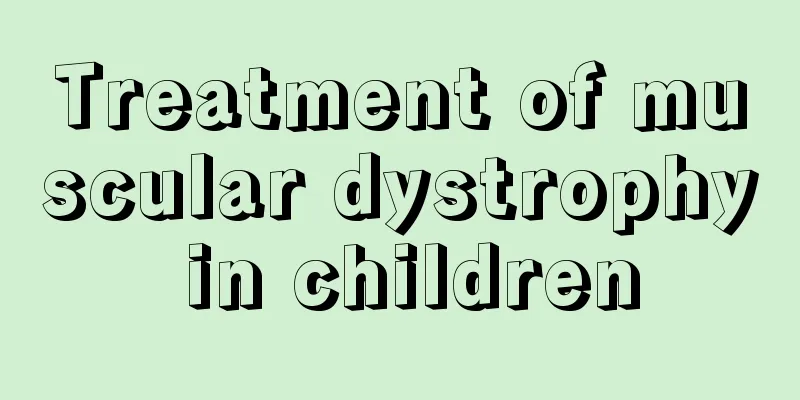Treatment of muscular dystrophy in children

|
I believe that every mother regards our own children as the flesh and blood of our hands, and wants to give their children the best. In fact, caring for children does not necessarily mean giving them the best material life, but we must make sure to prepare their daily breakfast so that they can replenish the various nutrients lacking in the body and grow better. Since many parents do not pay attention to this, many children suffer from muscular malnutrition. So, is there any good way to solve this problem? Let us now learn about the treatment of muscular dystrophy in children. Treatment: 1. Treatment of the cause Treat primary diseases such as chronic digestive system diseases and wasting diseases such as tuberculosis and heart, liver and kidney diseases. Promote scientific feeding knowledge to parents, encourage breastfeeding, add appropriate complementary foods, and wean your baby in time. Change bad eating habits such as picky eating and partial eating. 2. Treatment during the emergency period (1) Anti-infection Malnutrition and infection are closely related. The most common infections are gastrointestinal, respiratory and/or skin infections, and sepsis is also common. All require treatment with appropriate antibiotics. (2) Correction of water and electrolyte imbalance In the emergency treatment of malnutrition, the treatment of dehydration and electrolyte imbalance is particularly important, especially in children with diarrhea and malnutrition. The following points should be noted: ① Pay attention to the amount of fluid intake to prevent heart failure. ② Adjust and maintain electrolyte balance in the body: Malnourished children are often severely deficient in potassium. When urine excretion is normal, 6 to 8 mmol/(kg·d) of potassium can be given for at least 5 days. There is also a deficiency of calcium, magnesium, zinc and phosphorus, which, if not promptly treated, will be further aggravated by the administration of high-energy, high-tonic parenteral nutrition solutions. (3) Nutritional support After the fluid and electrolyte imbalance is corrected, the treatment of malnutrition depends on the degree of damage to the intestinal absorption function. If the intestinal absorption function is poor, central venous nutrition or peripheral venous nutrition can be used as needed. The former has a longer retention time and the concentration of the infused nutrient solution is higher, while the latter cannot exceed 5 days. The composition and amount of parenteral nutrition solution should be based on the child's fluid needs, generally 100 ml/(kg·d). The protein content is generally 2g/(kg·d). Fat is the main source of heat energy, providing 60% of total heat energy. When parenteral nutrition is used, serum glucose should be monitored every 6 hours to prevent the occurrence of hyperglycemia. Liver function should be monitored weekly. 3. Recovery period treatment (1) Provide sufficient energy and protein. When calculating energy and protein requirements, the average weight (or P50) of the corresponding age should be used instead of the actual weight of the child. The daily intake is the amount of energy and protein required per kilogram of body weight multiplied by the ideal body weight. (2) Food selection: Choose food that is suitable for the child's digestive ability and meets the nutritional needs. Try to choose high-protein and high-energy foods, such as dairy products and animal proteins such as eggs, fish, meat, poultry and soy products, as well as fresh vegetables and fruits. (3) Functional drug therapy to promote digestion and improve metabolism: various digestive enzymes such as pepsin and pancreatic enzymes are given to aid digestion. Appropriate use of anabolic steroids such as nandrolone phenylpropionate can promote protein synthesis in the body and increase appetite, but sufficient heat energy and protein should be supplied during medication. 4. Treatment of complications (1) Hypoglycemia is common, especially in the emaciated type. Generally, 10 ml of 505 glucose can be injected intravenously after blood sampling upon admission to the hospital for treatment. Later, 5% to 10% glucose solution can be used for fluid replacement. (2) Severe emaciation with hypothermia has a high mortality rate, which is mainly caused by insufficient heat energy. Pay attention to the ambient temperature (30-33°C), use a hot water bottle or other methods to keep warm (be careful of burns), and monitor body temperature at the same time, every 15 minutes if necessary. The above content introduces us to the treatment methods of childhood muscular dystrophy. All of our mothers can follow the above content to make the most nutritious breakfast for all of us, better balance our children’s dietary structure, let our children grow better, and solve the problems caused by childhood muscular dystrophy. |
<<: Treatment of cerebellar ataxia
>>: Causes and treatment of concealed penis in children
Recommend
What are the benefits of skipping rope for young children?
Thinking back to my childhood, the game I played ...
What causes herpes on the neck?
Most people do not have enough knowledge about he...
Reasons why babies love to rub their eyes
I believe everyone must know the importance of ey...
What should I do if my baby has a bad stomach?
Babies have poor gastrointestinal function and of...
What should I do if I get swollen after getting the vaccination?
Babies need to get a lot of vaccinations from bir...
Is it good for babies to have early teeth?
Many families are very concerned about the develo...
What to do if your child has oily ears
Children have ears, which is actually normal beca...
Is it good to bathe a newborn baby every day?
In fact, most mothers know that it is not good to...
What should I do if my seven-month-old baby has a fever of 38 degrees?
It is very common for babies to have a fever, and...
20-month-old baby's intellectual development
We all know that as the baby grows, mothers are p...
The importance of fundus examination in premature infants
Fundus examination of premature infants is a part...
What are the symptoms of qi deficiency in children?
When the body suffers from qi deficiency, it will...
Introduction to the sequence of puberty development in boys
Whether it is a boy or a girl, when they reach pu...
What food is good for children with cold?
Babies are often prone to catching colds due to t...
What to do if your child has chest pain
Every parent hopes that their child can grow up h...









